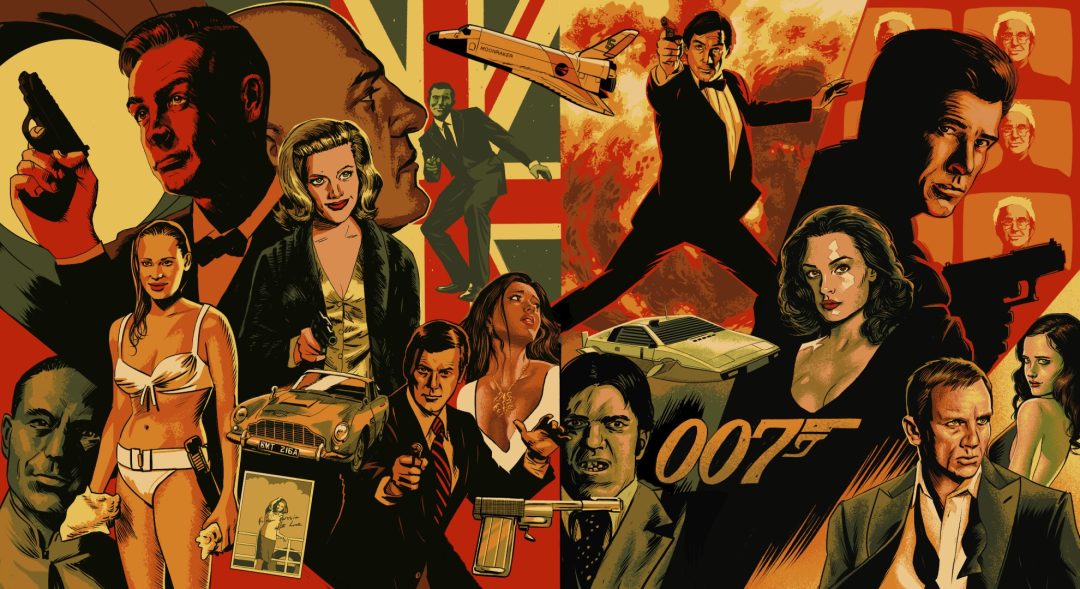You started this! You asked us to do the Bond movies in turn. Dr. No and From Russia With Love were on our old site, before the tech issues, but we picked right up again here with Goldfinger, then Thunderball. Now Stark and Wrenage return for a movie that managed to perform two directly-opposing tasks at the same time. It was simultaneously an example, to many, of the ultimate Bond-age, while at the same time being a harbinger of an upcoming struggle for the very survival of the franchise. Come with us as we delve into the curious beast that is You Only Live Twice.
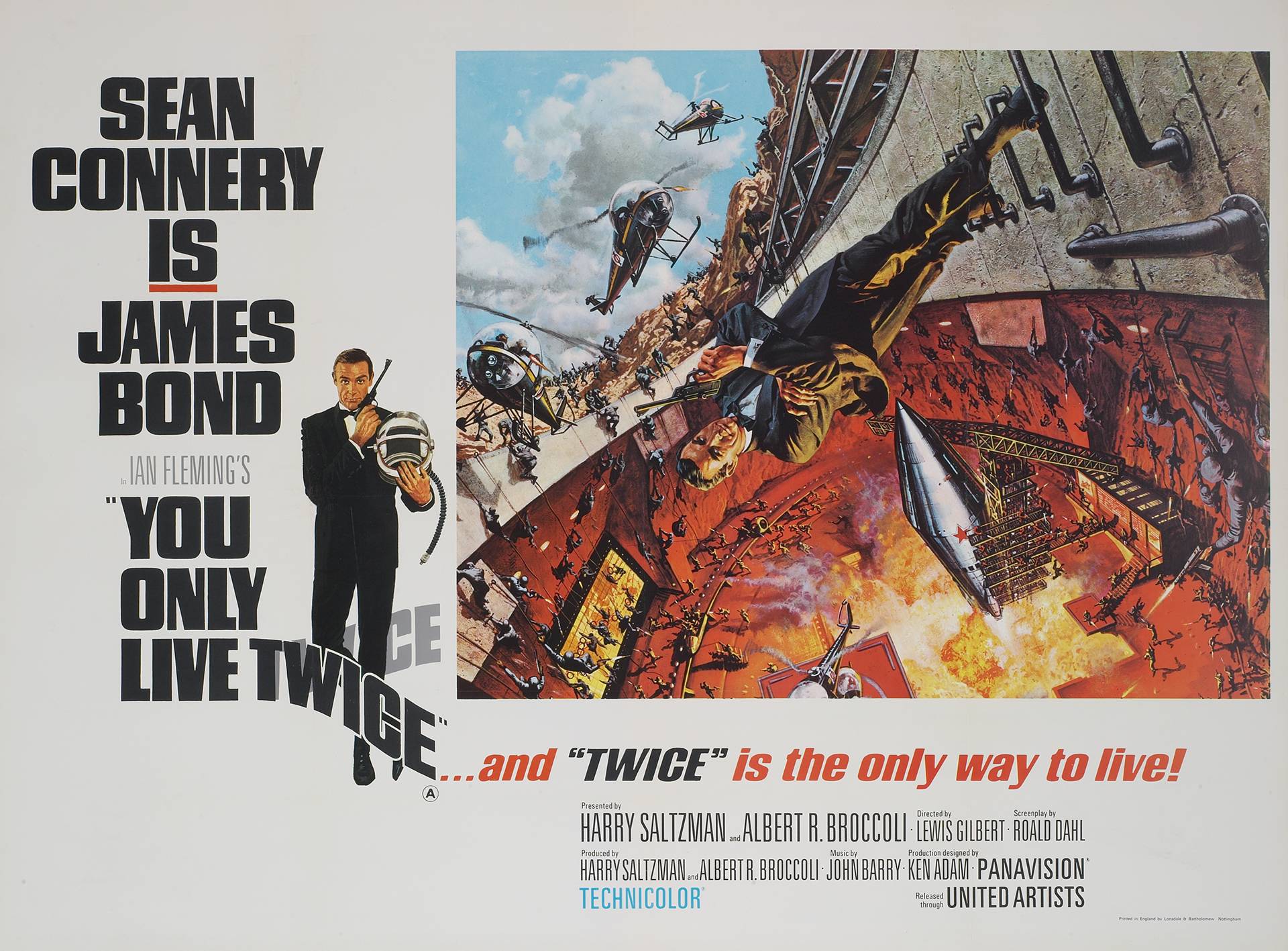
You Only Live Twice – Behind The Scenes
Thanks to James Bond, Sean Connery was now a bonafide global superstar and a genuine cinematic icon. Bond was a box office juggernaut and an entertainment phenomenon. Nothing could go wrong… right?
Sean Connery was becoming disenchanted with the role. He had been locked into standard rates for early Bond movies, with the producers refusing to renegotiate his contract. The studio kept him sweet with generous bonuses as the movies raked in cash across the world. Eventually, the producers relented and increased Connery’s fee considerably. Connery was also growing tired of the commitment. The movies were made back-to-back and with time spent filming and publicizing each movie, Connery had done little but Bond for five years straight.
This lack of a break made it difficult to do other work, which Connery feared was also leading to typecasting. In addition, he grew frustrated with the intrusion into his private life by the press, who hungrily sought anything they could find; such was the appetite for all things Bond. Saltzman and Broccoli were able to persuade Connery to stay by increasing his fee again for You Only Live Twice, but they were thinking they may need to look for a replacement, even before something happened on location that forced their hand.

On Her Majesty’s Secret Service was intended to follow Thunderball, mirroring the order of the books. The original Fleming novels feature what is known as the Spectre Trilogy. Thunderball introduces the nefarious organization, setting them on a collision course with Bond. On Her Majesty’s Secret Service pits Bond against Blofeld himself and culminates with the murder of Bond’s wife of only a few hours. You Only Live Twice is where a grief-stricken Bond takes his final revenge on Blofeld.
Producers decided to adapt You Only Live Twice first because On Her Majesty’s Secret Service would require high and snowy locations. Meanwhile, the Bond phenomenon was huge in Japan. The Japanese setting of You Only Live Twice allowed producers to harness this mania. This presented a challenge, as the original novels had a single narrative though-arc. Suddenly they were out of sequence.
The first draft of the script was written by Sydney Boehm and followed the original novel closely. Harold Jack Bloom then travelled to Japan with the producers to write a screenplay. His work was ultimately rejected, but several of his ideas made it into the final movie, such as Bond’s fake death and burial at sea, and the presence of ninjas in the final battle. The screenwriter of the previous Bond films, Richard Maibaum, was unavailable. Charlie And The Chocolate Factory writer Roald Dahl was a close friend of Ian Fleming. The producers tapped him up to write an adaption. Dahl immediately set about rewriting the entire story. He said it was:
“Fleming’s worst book, with no plot in it which would even make a movie.”
Dahl compared it to a travelogue rather than an adventure novel. He was given only six weeks to create the screenplay and was inspired by the story of a missing nuclear-armed U.S. Air Force bomber over Spain and by the Soviet Union and the United States’ recent spacewalks from Voskhod 2 and Gemini 4. Dahl was given free rein over how to approach this, with producers insisting on only the “Girl Formula” being non-negotiable. The story had to feature three women for Bond to seduce – an ally, a henchwoman (who both get killed), and the main Bond girl.
Lewis Gilbert originally declined the offer to direct but accepted after producer Albert R. Broccoli called him directly saying:
“You can’t give up this job. It’s the largest audience in the world.”
Gilbert worked closely with Dahl, and Dahl spoke highly of him:
“He not only helped in script conferences, but had some good ideas and then left you alone, and when you produced the finished thing, he shot it. Other directors have such an ego that they want to rewrite it and put their own dialogue in, and it’s usually disastrous. What I admired so much about Lewis Gilbert was that he just took the screenplay and shot it. That’s the way to direct: You either trust your writer or you don’t.”
Whereas other Bond movies were globetrotting, almost all of You Only Live Twice is set in Japan. Gilbert, Young, producers Broccoli and Harry Saltzman, and production designer Ken Adam went to Japan, spending three weeks searching for locations. SPECTRE’s shore fortress headquarters of the novel was changed to an extinct volcano after the team learned that the Japanese do not build castles by the sea. A lot of the location scouting was done by helicopter. It was while flying over volcanoes that Cubby realized a crater would make a great villain lair. Meanwhile, Gilbert had never flown in a helicopter and was terrified during such scouting. It didn’t help matters that their pilot was an old man with shaking hands. Once they got up in the air, the old pilot turned to Gilbert to offer reassurance.
“Me Kamikaze pilot,” he said.
It was also during this scouting trip that a stroke of fate happened. The group was due to return to the UK on a BOAC Boeing 707 flight (BOAC Flight 911) on 5 March 1966 but canceled at the last minute after being given the chance to view a ninja demonstration. BOAC Flight 911 crashed 25 minutes after takeoff, killing everyone on board.
The entire course of Bond history would have been completely different were it not for that chance intervention. In keeping with Fleming’s original novel, which also devoted a number of pages to the discussion of Japanese culture, a lot was made of Japanese customs and mindsets in the movie. Toho Studios provided soundstages and personnel to the producers. They also used their stable of contracted players to provide the female Japanese stars of You Only Live Twice.
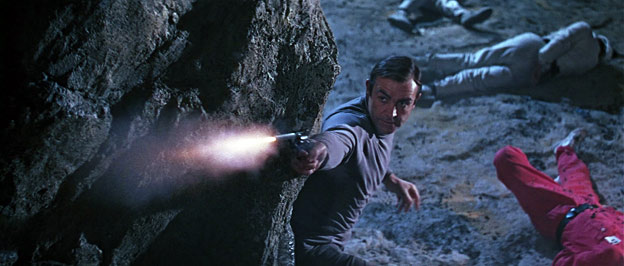
It was here that Connery’s mood was not improved by intrusions into his personal space and time. Large crowds were present in Japan to see the shooting. A Japanese fan began following Sean Connery with a camera, and police had to deal with fan incursions several times during shooting. In one famous incident, the Bond star was followed into a public bathroom by a photographer. This encounter left him furious. He let it be known that his £750,000 fee for You Only Live Twice was not enough and told the producers that if he was to return for a sixth, and final, time as 007 then they would have to pay him £1million and a share of the box office grosses. They declined, and it became his final turn as 007… for now.
Once he got home from Japan, Ken Adam started cooking on the volcano base. He, himself, admitted that a person had to be a little crazy to try it. He also knew that if the volcano base didn’t work, he would never work again. Big sets had been built before for movies like Ben Hur and The Fall of the Roman Empire, but none of them had a retractable roof to fly a helicopter through. The volcano base is spectacle filmmaking at its finest. Ken Adam likely had to have the crotch of his pants routinely let out.
When Cubby asked Adam how much the volcano set would cost, Adam quoted, “$1,000,000.”
Cubby, equally crazy, said, “If you can do it for that, do it.”
The volcano set used 700 tons of steelwork (more than the Hilton in London) and took 50 plasterers and 60 riggers working day and night to finish it. Naysayers said the Bond crew would never be able to light the gigantic set. Gilbert had an ace up the sleeve, however. He brought in Academy Award-winning cinematographer Freddie Young to lens You Only Live Twice. When asked if he could light the volcano base, Young said, “No problem.” He used pretty much every lamp the studio had, but he pulled it off.
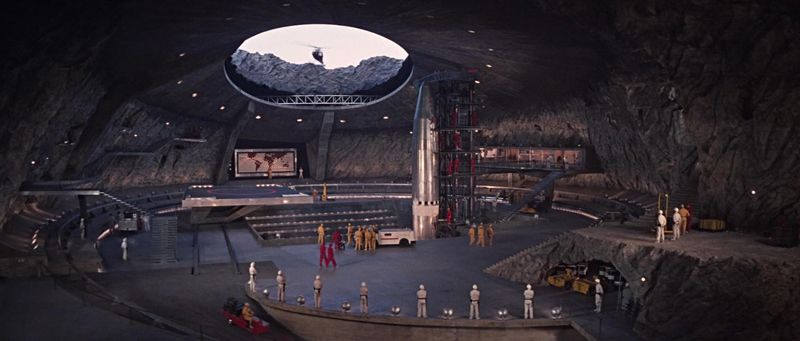
Other things did not go as smoothly. Filming You Only Live Twice threatened life and limb. Akiko Wakabayashi and Mei Hama did not speak English. The plan was to teach them the language as they filmed. Akiko picked it up pretty well. Mei did not. It got to a point where Gilbert realized he needed to let Mei go. He asked Tetsuro Tamba to deliver the bad news. Tamba reluctantly agreed. When Gilbert asked him how it went, Tamba told him Mei was so ashamed she planned to commit suicide. Gilbert quickly went to Cubby and informed him of the situation. Cubby’s response:
“You know, she’s not so bad, after all…”
Learning English wasn’t the only challenge for Mei. Swimming in treacherous currents caused problems for her and the other Japanese girls, as well. Connery’s wife, Diane Cilento, stepped up. She was athletic enough to handle the tides and doubled for the actresses in the swimming scenes.
The Occidental Bond Girl, Karin Dor, had her share of bad luck, too. Dor was filming on the set where she gets Bond a glass of morning champagne. As she stepped away from the bar, one of the studio lights crashed where she stood seconds before.
Filming the Little Nellie sequence is where things truly got hairy, however. The scene required 85 take-offs and landings and 46 hours of flight time to get 7.5 minutes of screentime. Many of the take-offs and landings were dangerous, as the pilot did not have a lot of ground to work with on the mountainside.
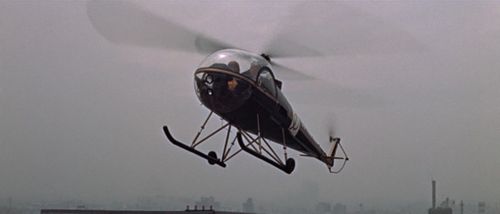
It was another man who ended up being injured, however. John Jordan was the aerial cameraman on You Only Live Twice. He was leaning out of a helicopter and filming another chopper beneath him. An updraft hit the lower copter and pushed it upward. Its blades cut away a good portion of the skid Jordan leaned out on…along with slicing through most of his leg. The pilot of the damaged helicopter managed to land it without it tipping over. Guess who that pilot was… Yep, Mr. Kamikaze himself!
Jordan was immediately rushed to a hospital. Cubby and Saltzman made sure Jordan had the best doctors and care. Nevertheless, the leg didn’t heal right and caused Jordan enough pain that he decided amputation was the best course of action. Jordan healed up and got back to aerial photography. The danger of the profession spared him on You Only Live Twice, but it didn’t spare him a second time. Jordan died while filming aerial scenes for Catch 22.
The haiku Ian Fleming wrote for You Only Live Twice means a lot of people working on the film got two lives. The poem is also awesome enough to be an edge-lord tattoo:
You only live twice,
Once when you are born,
And once when you look death in the face…
Do You Expect Us To Talk?
Stark: Right… here we go. Potentially a re-run of Goldfinger here. Despite this being a famous entry in the Bond canon with its volcano lair, ninjas, gadgets, bald and scarred Blofeld, complete with piranha tank and all the other paraphernalia, I don’t rate it that highly. Yeah, yeah, I know what you are thinking – “Call yourself a Bond fan, Stark?”
Yes, yes I do. I am a HUGE Bond fan. I am sitting here surrounded by personal reference books as I research this article. Porter’s The James Bond Lexicon, Field and Choudhury’s Some Kind Of Hero, even all 9kg of Taschen’s The James Bond Archive, still the most expensive book I own. My early edition Fleming novels, which were my father’s, have a place of pride on my office bookshelf behind me. I am a huge Fleming fan too, and this movie is, to me, where the movies started to diverge so wildly from Fleming into the fantastical. Frankly, it feels like an episode of Thunderbirds in places.
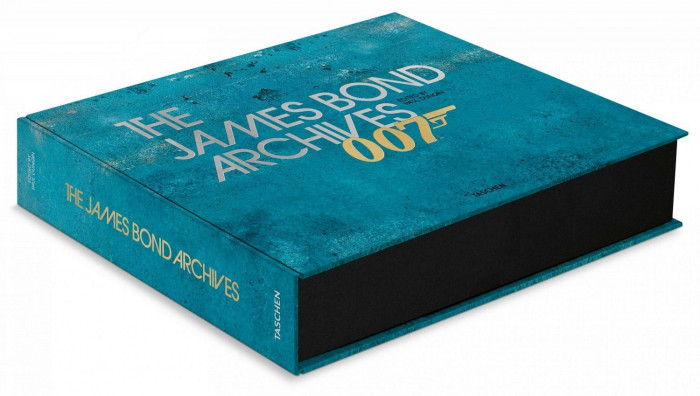
As a child, Dahl was my favorite storyteller. It feels like he should have stuck to foxes and chocolate factories. This is weird, as there are some Moore entries that I love with all my heart and this feels like the first move in that direction. So once again, I am hypocritical and inconsistent, but I like what I like and You Only Live Twice isn’t high up my list. Don’t misunderstand me here, as my theory remains undefeated – Bond is like pizza and sex. Even when it is kinda bad, it’s still kinda good and you are glad you had it – You Only Live Twice flirts dangerously close with “kinda bad” for me.
Wrenage: You Only Live Twice is my guilty-pleasure Connery Bond. It is the inverse of Thunderball. Both are spectacle Bonds. Thunderball has the better plot but bogs down. You Only Live Twice has a wonky plot but moves along at a breezy pace. You Only Live Twice is stuffed with fights, chases and gunplay. The gaps between these things are packed with piranha pools and Pac-Man space capsules. I greatly enjoy the rocket scenes in You Only Live Twice. They look straight out a 1950s drive-in movie. The space-walking astronaut who gets his air hose cut is also a nice touch.
One thing that elevates You Only Live Twice is that it looks great. Freddie Young also lensed a couple of other movies you may have heard of: Lawrence of Arabia and Doctor Zhivago. Throughout You Only Live Twice, one is struck by some nice frames. One that stood out to me was when Tanaka’s ninja army crests the rim of the volcano and stands along it, silhouetted in the night.
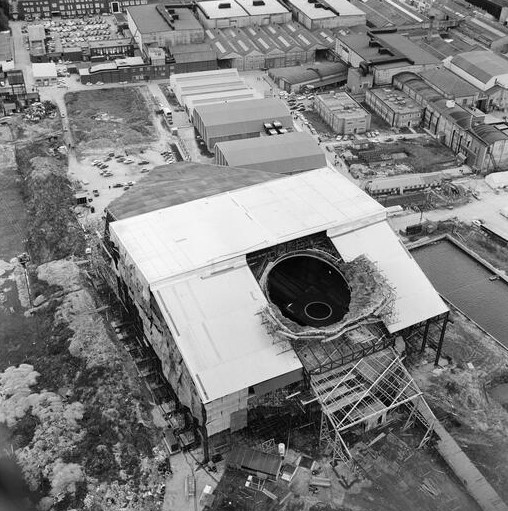
Young and first-time Bond director Lewis Gilbert were a solid one-two punch. Gilbert ended up doing three Bond films, or maybe 2.5 is a better way to put it. The Spy Who Loved Me is basically the plot of You Only Live Twice refined. Gilbert started out as a child actor and joined the Royal Air Force film unit during World War II. He then worked for the U.S. Army Air Force. Gilbert only recently left this world. He passed away in 2018 at the age of 97. Gilbert brought a more overt sense of fun to the Bond movies — some might say maybe too much fun. As for me and my house, we are pro-Gilbert.
Stark: So we are diverging again here? You know it’s a “guilty pleasure,” so deep down you must know the truth? Ha ha! Listening to your points, it feels as if you watch it as a movie, and I watch it as a Bond movie, perhaps? I am always comparing this to other Bond films. Plus my fan prejudices, including being into Fleming, come into play and cloud my opinion of this movie. Which is weird, as I love The Spy Who Loved Me deeply. Maybe I am just a rag-bag of contradictions and inconsistencies when it comes to Bond!
Wrenage: You are definitely the bigger Bond aficionado when it comes to the Bond universe. You have a knowledge of the books that I don’t posses. Ergo, you are probably right. I view these movies more as movies, and you view them within the greater scope of all things Bond and Fleming. Looking at You Only Live Twice from a more purist point of view, your stance makes perfect sense. This a good thing. It keeps our scores honest because we hopefully cancel out the worst tendencies of our individual biases. Frankly, EON Productions should have us on their payroll. You think there would be any Tarzan yells or Bond falling for lame women in any Bond movies we oversaw with militant hubris and cruelty? Not on your life! All EON would get is quality movies, weeping production assistants and a few lawsuits, certainly. But we could settle all of those out of court for very reasonable sums…
Stark: I wonder if my early edition Fleming paperbacks would cover my legal costs?
Ranking And Rating
Enough with the preamble, let’s get to the ratings and rankings. Wrenage and Stark will give their opinions on the Bondian elements found in You Only Live Twice and come up with a score and ranking in an attempt to place this in its rightful place in the all-time pantheon of 007. Scores on the door!
Bond
Stark: You can tell Connery was growing weary of the role by this point. He’s not as bad as he will be in Diamonds Are Forever, but the undeniable high of his performances in Goldfinger and Thunderball is just not there.
Wrenage: Connery’s frustration with fame and the Bond system seems to come through onscreen in You Only Live Twice. His performance comes off as slightly fatigued. It is hard to put one’s finger on it exactly, but some of his readings sound mechanical, and he doesn’t have the same spring in his step. Connery also doesn’t appear to be in the same shape physically. He is a smidge bloated and stooped.
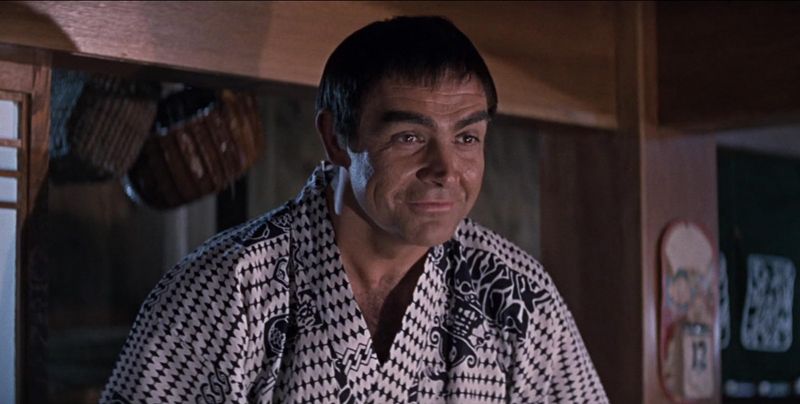
On the other hand, stooping comes in handy for Bond’s transformation into a Japanese fisherman — truly an astonishing feat of makeup. Not only could Connery pass for Japanese, he could pass for Bob Hope. The only makeup creation I can think of that achieved something this audacious was Tim Curry’s transformation in Legend. Likely, when Rob Bottin laid awake at night, wondering how he could turn Curry into a devil with full-size ox horns and came to the conclusion it was impossible, he looked to You Only Live Twice for inspiration that something that crazy could be done.
I kid, I kid! The whole Bond turning Japanese is pretty clumsy and stops the movie dead, as it feels the need to also show Bond marry a girl the audience has never seen before. Conceptually, it makes some sense. It is an interesting way to move Bond from point A to point B within the plot. Unfortunately, not all interesting ideas turn out to be good ideas in execution.
Stark: Yet, strangely, the only time in the movie that Connery seems really happy and relaxed is during those scenes… scenes which, I agree, are just strange. They are not in the book. He does go and spend time in a fishing village as he prepares to infiltrate Blofeld’s lair, but there are no prosthetic eyelids evident in the book. I am not sure why they decided on this route. For me, this is Exhibit A on my list of why You Only Live Twice is just a little too out there for the Connery-led Bond of the 1960s. Maybe they think they are doing a clever re-working of the very end of the novel where certain things happen, but not like this!
Bond Girl
Wrenage: The Bond Girl element is one area where You Only Live Twice is weak. Aki is likeable, if not redundant. She rescues Bond from in front of the same building in the same car twice. Beyond that, she doesn’t get to do much. The movie casts her aside for Bond’s bride, which is where the element truly breaks down. We are supposed to believe Kissy is so great that Bond immediately falls for her when she has nothing going for her beyond the script deeming Bond falls for her.

On the other hand, the demise of Aki is nicely done. The poison-on-a-string scene is genuinely cinematic as a form of assassination and is creepily filmed. Ultimately, this undercuts Kissy because Aki’s death carries a degree of weight within the story. Kissy can’t compete with that, so when she enters the picture, she is immediately an also-ran Bond Girl. In the end, all of this is probably the result of needing to force in the requisite Bond Girl formula: one to kill, one to fall in love with, and one who tries to kill Bond.
Stark: You do get the impression, though, that there were genuine feelings between Bond and Aki, and he is moved by her death. She’s a capable, spirited woman too. In movie chronology perhaps she would have become Mrs. Bond, if not for the assassin. This, as you say, causes issues later because then Kissy is just… there! Bond can’t have been that upset because just after Aki is killed, he’s balls deep in Kissy. This also means that Kissy, as a character, is very poorly served. Anyone who knows anything about the literary Bond knows that Kissy is an important character, and the ending of the novel leaves one hell of a thread dangling. A thread that comes back on Bond later in his career in the Raymond Benson continuation novels, and that they picked at for No Time To Die.
Wrenage: I did not know any of of this. I will have to take Google for a spin and fill in these gaps of Bond knowledge. I definitely would have liked to see Aki go to the end of the movie. Within the film of You Only Live Twice, there is really no reason for Kissy. Aki could have done all Kissy did and better. I’d hate to lose the assassination by poison string, though. That still has to be used on someone. Maybe that could have gotten Helga. She seduced Bond to get him in bed for the poison string, but it gets her instead. Then Mr. Osato could have gotten eaten by piranhas. Something like that. Needs a bit of refinement, but it proves my point. None of these issues would happen on our watch!
Stark: Get the Brocolli family on the phone immediately!
Villains
Stark: The archetypal Blofeld makes his first full appearance, and the character will never quite live it down – looking at you, Austin Powers! In the novels Blofeld is described clearly as a physically massive man, weighing roughly 20 stones (280 lb; 130 kg). He has black crew-cut hair, black eyes similar to those of Benito Mussolini, heavy eyelashes, a thin mouth, and long pointed hands and feet. He has violet-scented breath from chewing flavored breath mints. How they went from that to Donald Pleasance is beyond me. But they did, and now we have that Blofeld etched forever in our minds.
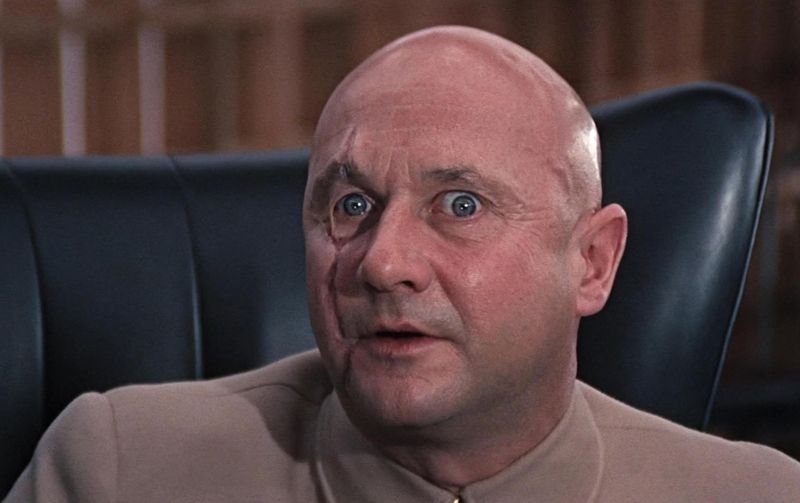
Wrenage: You Only Live Twice has a full gallery of villains. It’s got Blofeld, Mr. Osato, Helga, two thugs for Bond to beat up and other assorted henchmen to dispatch. This amount of villains means they are all fairly thin as threats since they never get a lot of screentime to flex their muscle.
You Only Live Twice does give us our first look at Blofeld’s face, however. Jan Werich was originally cast, but Gilbert didn’t like him for the part. Gilbert said Werich looked like a “poor benevolent Father Christmas.” Donald Pleasance was then brought in. You can’t really go wrong with Donald Pleasance. He’s got big weirdo energy, and Pleasance really brings the crazy eyes to You Only Live Twice.
Stark: And a guest appearance from Dwayne “The Rock” Johnson’s grandfather as the thug Bond fights around the safe at Osata Chemicals. Helga Brandt is a great bad girl, to me. You can just tell she’s not good, that she would f**k you up, but you still would! We have all known a few women like that in our lives. I made the mistake of marrying one the first time around. She never tried to kill me in a plane crash though, but I reckon she at least thought about it! The piranha tank remains such an unbelievably “Blofeld” thing to have. Shame she had to meet her end in it.

Wrenage: Also, Burt Kwok, who plays Kato in the Pink Panther movies, makes his second appearance in a Bond film. His first was Goldfinger. In addition, a very young Ric Young is in You Only Live Twice. Young was one of the bad guys in the beginning of Indiana Jones and the Temple of Doom. You know the one…
Too much to drink, Dr. Jones!?
Plot
Stark: As you have mentioned, the plot will be basically reused later for The Spy Who Loved Me, which I love. So why do I have a negative view of this movie? It is the extravagance of the execution. It needs reigning in a little.
Wrenage: The plot of You Only Live Twice is a bit extravagant compared to the previous Bonds. Roald Dahl, a wonderful, wonderful writer, said he didn’t know what to do when assigned to write the screenplay. He decided to follow the basic plot of Dr. No. Alas, Dahl didn’t get a chance to include any of his trademark twisty nastiness, which shows up in his shorter works. Overall, it plays out fine. The plot puts Bond on a trail, has him meet friends along the way, and ends up at a place that blows up good. The Pac-Man space capsule gag is also great fun. That had to be Dahl. Something like that would fit right in a world that contains wacky chocolate factories. Admittedly, none of it truly feels like a Bond movie. You Only Live Twice comes off as more of a British military sci-fi movie, like Battle Beneath the Earth or something.
Earlier, you compared You Only Live Twice to an episode of Thunderbirds. That also is not far off the mark. The Japanese settings, the volcano lair, ninjas, rocket guns, monorails, and the space stuff give the movie a flavor of its own. Not even the other Bond space adventure, Moonraker, feels as fantasy-based. You Only Live Twice might even brush up against the dieselpunk genre of fiction.
Stark: Feeling a bit like an episode of Thunderbirds is not necessarily a bad thing, except in 1960s Bond. It just feels off to me, hence my downer on this movie. I am also not sure I can let your use of the word “Dieselpunk” slide either, because it sounds somehow worse than Steampunk which, as we know, is Cosplay’s even less welcome little brother.
Wrenage: I just learned the word “Dieselpunk,” and I’ve been finding a surprising number of uses for it. It’s very wizard!
Stark: Watch it!
Action Sequences
Wrenage: You Only Live Twice got the action right. Bond gets not one, but two, From Russia With Love-inspired brawls against a Japanese henchman and an Aryan thug. There are a couple of short car chases. One ends with an electric magnet gag that was the idea of Cubby’s wife, Dana. The action highlights of the film are Little Nellie and the volcano assault. The Little Nellie scenes are great fun, albeit a bit gag-heavy. More straight-forward dogfighting might have been better, but what are you going to do? Gyrocopters were pretty techy at the time, so you have to lean into it.
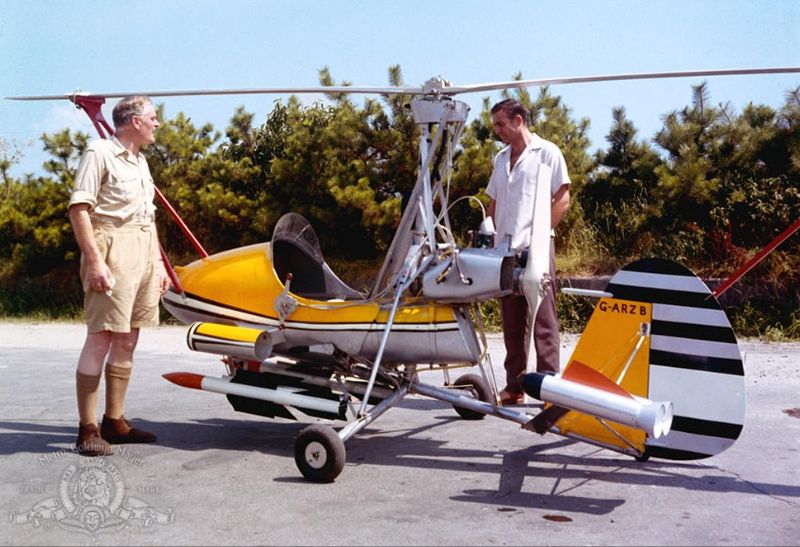
The assault on the volcano is great mayhem. The swarm of ninjas doing rope descents is crazy. Bob Simmons was in charge of that. He knew of a technique for fast rope descents. One put a sleeve of fire hose over the rope, held on to it, and dropped. When one wanted to stop, one twisted on the fire-hose sleeve, which arrested the rappeler’s descent. One stuntman didn’t have the timing down, landed too hard, and broke bones in both of his legs. You Only Live Twice was also one of the first movies to use trampolines to propel characters into the air to simulate the effects of explosions. Neat!
Stark: The biggest scene that sticks in my mind, strangely, is the fight at Kobe docks, and the camera pan out across the roof with that iconic Bond action riff playing. The volcano lair, ninjas, Little Nellie, and the magnet gag are all things in my “too much” bucket for this movie. It’s all just a bit too much, like another latter Bond movie that fouled its own nest, but we will talk about Die Another Day when we get around to it!
Wrenage: *making mental note to mess up Stark’s Die Another Day score…*
Pre-Title Sequence
Stark: The use of Barry’s iconic “Space March” theme makes the opening scene. Also, the cutting off of everything as the cable is snipped by the closing jaws of the SPECTRE rocket is great, and quite chilling, in context.
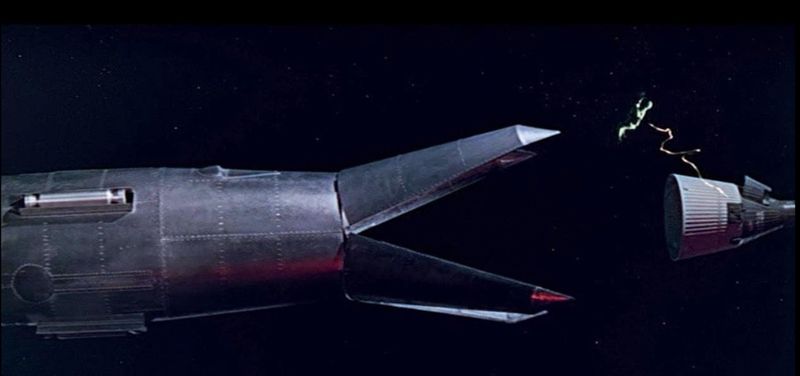
Wrenage: The SPECTRE space vehicle eating the American space vehicle is a great opening. Unfortunately, Bond dying was already used in From Russia With Love. They might have been trying to mess with audiences, as rumors were already swirling it was going to be Connery’s last Bond. It is maybe similar to Wrath of Khan where Nicholas Meyer knew the audience expected Spock’s death, so he “killed” Spock in the opening scene to make the audience believe it was all a fake-out. Folks didn’t have the Internet then to speculate all of these things to an OCD level before the film came out.
Stark: Imagine the internet in the time of The Empire Strikes Back? Doesn’t bear thinking about! The novel ends with Bond in a very different place, famously with his obituary written and a eulogy that includes the poem Ralph Feinnes’ M reads for him at the end of No Time To Die. It feels as if the movie version of You Only Live Twice is trying to leverage the ending of the book at the beginning to, as you say, screw with audience expectations.
Theme Song
Stark: It is a sign of how huge James Bond was at the time, that Nancy Sinatra was apparently terrified of recording the theme and needed calming down by John Barry. She was kind of overawed by being involved in the whole Bond thing, and she admits she nearly didn’t get on the flight to London to record it. The song itself has that hook that remains throughout the whole movie. It’s probably a top-half Bond theme in the whole pantheon.
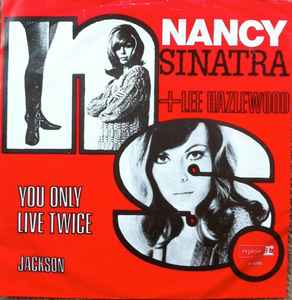
Wrenage: You Only Live Twice by Nancy Sinatra has a nice melody. It is surprisingly catchy. Its theme is also used throughout the film to good effect. Beyond that, Barry’s score is unremarkable.
Stark: Unremarkable? Space March? The fight at Kobe dock music? Have you been working out in the sun too much again?
Wrenage: Upon consideration, you may be right. Truth be told, I still have Barry’s score for the assault on Fort Knox in Goldfinger playing in my head. It is hard for subsequent Bond films to get that ear worm out of my brain. That song is my jam, man!
X-Factor
Stark: Yes, Japan is exotic, but since the whole movie simply visits Hong Kong (for 3 minutes) and Japan, it lacks that travelogue feel, so it loses X-Factor points for me. An interesting look at rural Japan is lost in prosthetic eyelids and bowl-cut wigs, too.
Wrenage: You Only Live Twice is the first appearance of ninjas in a big mainstream film. Who knows where ninja fans would be without You Only Live Twice. Would we have gotten Chuck Norris’ The Octagon? Would we have gotten G.I. Joe’s Storm Shadow? Would we have gotten Sho Kusogi and the Cannon ninja films? All ninja fans may owe a debt of gratitude to You Only Live Twice.
The Blofeld reveal probably deserves consideration as an X-factor, as well.
Stark: All the while damning us to a stereotypical view of Bond’s greatest adversary? One it will never shake off. I can’t give it extra points for that. I just can’t.
Wrenage: I had no idea of the books’ description of Blofeld until you revealed it earlier. With that in mind, Donald Pleasance is a bit disappointing. I wonder if having a hulking Blofeld would have negated the impact of of Richard Kiel’s Jaws in future Bond films, though. Jaws really was crazy popular. Kids loved that guy.
Scoring Breakdown
| Stark | Wrenage | |
| Bond | 6 | 6 |
| Bond Girl | 5 | 6 |
| Villain | 6 | 7 |
| Plot | 6 | 7 |
| Action Sequences | 7 | 9 |
| Pre-Title Sequence | 6 | 6 |
| Theme Song | 6 | 7 |
| X-Factor | 6 | 7 |
| TOTAL | 48 | 55 |
Stark: The biggest gap we have had between our scores so far. Even when our thinking has diverged on Goldfinger and Thunderball, the scores have evened out a bit. To me, You Only Live Twice lives on its own legend, and it’s nowhere near as good, when viewed objectively, as it thinks it is.
Wrenage: For me, You Only Live Twice is more than the sum of its parts. Connery is not at his best, and other elements are not at their peak either. Yet, action, pace, imagination, and a great look help the movie overcome all of that. You Only Live Twice ends up being the most lively of the Connery Bonds. It’s a fun watch and one I revisit often. I also find our scores interesting. Overall, we end up with the biggest gap, but on an individual element basis, most of our scores only differ by one point.
Overall Rankings
First Tier:
From Russia With Love (61.5)
Goldfinger (54.5)
Thunderball (53)
You Only Live Twice (51.5)
Dr. No (49.5)
Second Tier:
(Empty)
Third Tier:
(Empty)
Fourth Tier:
(Empty)
That’s A Wrap
Stark: I do have to admit, despite my negativity, that without You Only Live Twice we never would have gotten The Man With The Golden Gun, The Spy Who Loved Me, and Moonraker. This is like the pre-cursor for a lot of what was to come as they moved further away from the novels. I am interested in what happens next with the scoring. We are moving into very troubled territory with the arrival of Lazenby, Connery’s special deal, and then the arrival of Sir Roger of Moore. That first tier is looking kinda crowded. Something is going to have to be bumped down next time around.
I am also going to need a steward’s inquiry. Ain’t no way, no way, that You Only Live Twice is better than Dr No. I demand a recount!
Wrenage: I am mostly okay with the ranking so far. Mostly. I’d push You Only Live Twice above Thunderball and close the gap between From Russia With Love and Goldfinger, but whatever. It is all moot anyway once EON hires us. Our movie will score a perfect 80 and totally crash the system. Until then, I look forward to establishing the bump-down rules for moving movies between tiers! Onward and beyond!
Next time, Stark and Wrenage return with a look at the troubled, famous, and sometimes divisive On Her Majesty’s Secret Service.
Check back every day for movie news and reviews at the Last Movie Outpost


